176 Search Results for prompt
May 15, 2017
by Carole Zangari -
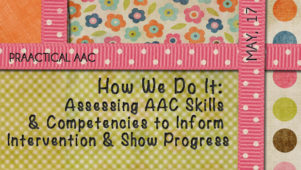
It’s Better Hearing and Speech Month ( #BHSM) and we are highlighting the work of talented AAC SLPs. We’re so happy to have Georgia-based Vicki Clarke back, this time with Holly Schneider, to talk about a longstanding collaboration that more AAC teams need to know about. Vicki’s private practice, Dynamic Therapy Associates, centers on AAC assessment and intervention. She works both with individuals and school districts, and serves children and adults with a variety of challenges and etiologies (e.g., motor disorders, memory, attention and learning difficulties, sensory impairment, neurological differences, syndromes and seizure disorders, congenital and acquired difficulties).Holly is a full time employee of Tobii Dynavox on the Clinical Content and Training Team. She is responsible for developing AAC training materials; and educating teams, professionals and families on AAC applications and implementation. In this post, they tell us about the development of the second edition of the Dynamic AAC Goals Grid.... [Read More...]
March 16, 2017
by Carole Zangari -
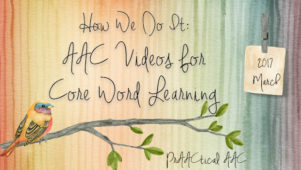
Have you ever thought of making short videos to illustrate the meaning of the core words you are teaching to your AAC learners? If so, this post is right up your alley. Teacher Angie Sheets and SLP Nicole Wingate have teamed up to bring the power of video to core vocabulary instruction and are here to share the fruits of their labor. For the past 17 years, Angie has been teaching Intense Interventions to students from kindergarten through grade 4 at Bluffton Harrison Elementary School. Her AAC experiences range from “DIY on the fly” (anything that can be made in a classroom at little to no cost and meets an immediate need) to high tech. (You can follow her on Twitter @asheetsroom14). Nicole also works for the Bluffton Harrison school system, servicing pre-k through 12th grade students. Her AAC experience includes no tech (e.g., picture boards, PECS), low tech (e.g.,... [Read More...]
February 16, 2017
by Carole Zangari -

It’s exciting to see more and more teams on the road to implementing AAC in therapy and in the classroom. Often, though, our initial expectations for student progress don’t pan out. Consider these examples. Aleksander’s SGD has robust vocabulary that is customized specifically for him. He uses it consistently at snack and lunch time, but rarely uses it in other activities. Ariel uses her AAC app to ask for things, make comments, and answer questions but rarely goes beyond the single word level to express herself. Jayson had a PECS book for over a year and learned to request his favorite foods but not much else. His team switched Jayson over to a more robust AAC system, and while he learned to communicate for other reasons, he still doesn’t use his communication book very frequently unless he’s prompted to do so. Do these situations seem vaguely familiar? Helping AAC learners become... [Read More...]
January 29, 2017
by Carole Zangari -
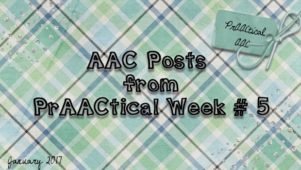
Can it really be the last week of January?! It was a great month for AAC learning, checking in with on-going projects, and planning for new ones. I’m looking forward to conversations with AAC stakeholders from around the world this Wednesday on Twitter, as I host the #ATchat (Feb 1, 8:00 pm ET). If you are new to Twitter or Twitter Chats or just don’t ‘get’ how it can support professional growth, you can learn more about that here. Even if you are an infrequent Twitter user, or if you are more of a lurker than a participant, we welcome you to join us. In the meantime, here are some of last week’s posts that you may have missed. Monday: AAC Mythology v2.0: A Few Misconceptions About AAC Intervention Wednesday: Video of the Week: Embedding AAC Throughout the Day Thursday: Reducing Prompt Dependence in AAC Learners: 5 Things to Try While you’re thinking about... [Read More...]
October 27, 2016
by Carole Zangari -
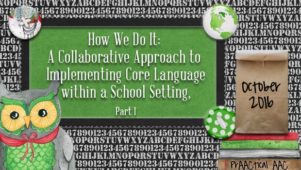
Nothing makes us smile like seeing teams in which professionals serving students with AAC needs work together to ensure that those students can use and grow their language skills. In this guest post, we learn about an approach that has worked for one such team, Lori Sanzeri and Chelsea Collins. Lori Sanzeri, MA CCC-SLP, TSHH, received her B.S. in Speech Language Pathology from SUNY Cortland in 2003 and M.A. from St. John’s University in 2009. She has worked for the NYC Department of Education since 2003 and teaches AAC and phonetics at St. John’s University. Chelsea Collins, MS CCC-SLP, TSSLD, received her B.S. in Special Education from Seton Hall University in 2009 and M.S. in Communicative Sciences and Disorders from New York University in 2012. She has worked for the NYC DOE since 2012 and specializes in AAC and early intervention. They are on Instagram as @thelanguageladies and have a Facebook page as... [Read More...]
September 22, 2016
by Carole Zangari -
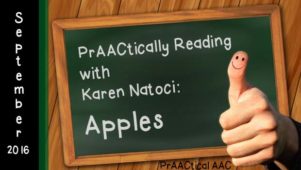
We are so happy to welcome back SLP Karen Natoci who graciously agreed to continue writing about how she uses interactive book reading to build language skills with beginning communicators. You can see her earlier posts in the PrAACtically Reading series here. In this post, she shares activity ideas for two books on apples. You can learn more about Karen and download her materials toward the bottom of the post. Enjoy! ::::::::::::::::::::::::::::::::::::::::::::::::::::::::: Books: Apples by Ken Robbins and Apples for Everyone by Jill Esbaum Adapted and simplified Powerpoint Book Apples by Karen Natoci Core Vocabulary focus: here, in, where Additional Vocabulary focus: Body parts; red, round, yellow, green, COMMUNICATION Matrix (Rowland, 2009) Level: I-VII (all levels!) ————————————————————————————————————————————- It is September and apple time! I chose to feature these books from which to adapt material suitable for students with complex communication needs. I have a simplified power point... [Read More...]
September 7, 2016
by Carole Zangari -
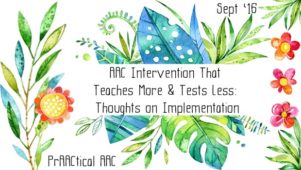
In an earlier post, I shared a graphic on the ways that AAC skills are ‘taught’ versus ‘caught.’ Teaching AAC skills involves the use of specific instructional strategies that give learners information and experiences which result in them being able to communicate more effectively. In many instances, we set out to do just that, but end up with an interaction that ‘catches’ what the student already knows how to do, rather than helping them gain additional skills. There are a few important concepts here. They both have an important role. ‘Catching’ skills isn’t bad. We can do this to figure out what the learner already knows/can do, and give him/her practice with the skill so that it becomes faster and easier to produce. When our interactions ‘catch’ a skill, we’ve created (or taken advantage of) an opportunity for communication. That’s important BUT, it isn’t teaching them anything new. Our learners do... [Read More...]
August 31, 2016
by Carole Zangari -
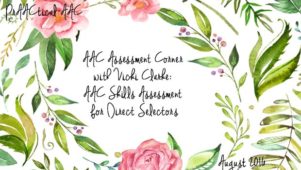
The month of August is almost over and we’ve saved the best for last. The month wouldn’t seem complete without hearing more of Vicki Clarke’s ideas on AAC assessment. In addition to many other things, Vicki’s practice, Dynamic Therapy Associates, does 50+ of these evaluations each year, both in the clinic and in school settings. In this post, Vicki shares some thoughts on assessing the AAC skills of people who use direct selection. As always, she packs in a lot of information and generously provides the protocol and data collection forms that she uses. You can explore some of her previous posts in the AAC Assessment Corner series here. * ::::::::::::::::::::::::::::::::::::::::::::::::::::::::::::::::::::::::::::::::::::::::::::::::::: AAC Skills Assessment for Direct Selectors I spent the morning with a great group of students at the University of Georgia (UGA) in Dr. Satterfield’s AAC class. I was asked to talk with them about AAC assessment with an emphasis on... [Read More...]
February 2, 2016
by Carole Zangari -

I had a wonderful time this past weekend connecting with colleagues and learning from ASD experts at the 2016 Center for Autism and Related Disabilities (CARD) Conference in Orlando. One of the keynotes, “From Building Social Relationships to Improved Quality of Life Outcomes for Youth on the Autism Spectrum: We Finally Know What We Already Knew,” was given by Dr. Scott Bellini. I also attended his talk on the Building Social Relationships program. Here are some of the take-aways from those two sessions. Evidence Base The evidence base for social skills training is variable. While his meta-analysis on school-based social skills training found that social skills interventions were minimally effective, there are several effective strategies that can be used in that and other settings. When evidence-based strategies, including video modeling and video self-modeling and social narratives, are used within the context of social skills training, the overall efficacy is much greater. The evidence... [Read More...]
November 25, 2015
by Carole Zangari -
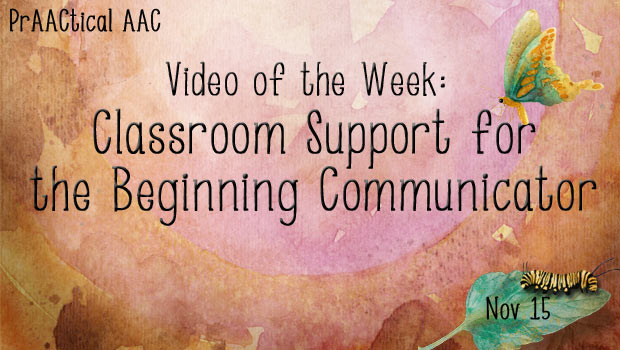
Gabriella doesn’t seem to notice what her teachers and peers are doing in the classroom. When offered a choice of toys, she seems to reach for one rather randomly, has little interest in the one she chose, and knocks it to the floor after 30 seconds. Elliot is assertive in greeting visitors to his classroom, and eagerly leads them around the room, vocalizing excitedly as he shows them around. When he needs help with a toy or material, he hands it to an adult with clear intent and expectation. He’s not using actual words just yet, and his interest in PECS has been limited. Alyssa uses a communication board to make requests and answer questions, but only with a lot of prompting. She uses single symbol utterances in planned communication opportunities during a few activities during the school day. Team members have observed spontaneous use of her AAC tools a... [Read More...]









